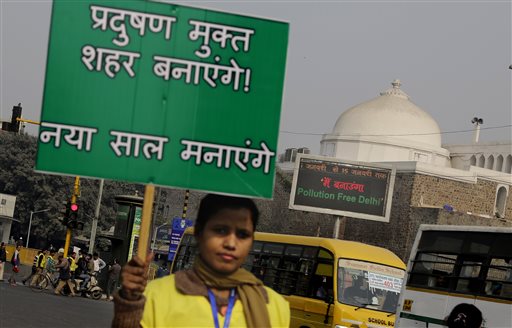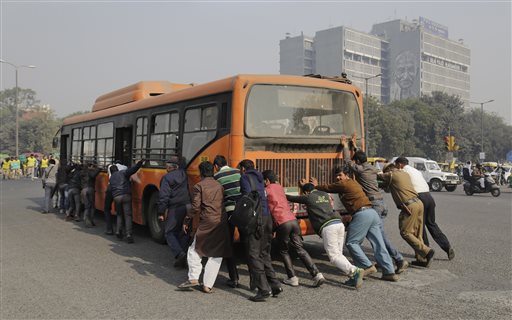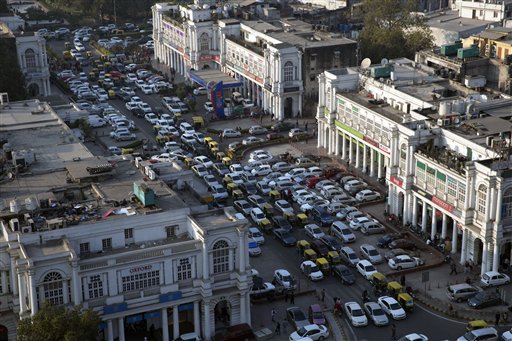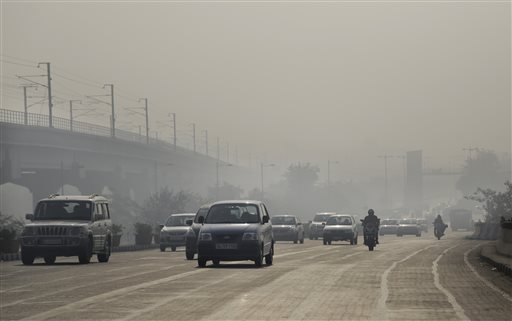‘World’s most polluted city’ starts limiting cars for 2 weeks to clear air

A volunteer holds a placard which reads “We will make a pollution free city” at a traffic intersection usually congested, on the first day of a two-week experiment to reduce the number of cars to fight pollution in New Delhi, India, Friday, Jan. 1, 2016. AP
NEW DELHI — The Indian capital on Friday kicked off a sweeping plan to reduce its record-high air pollution by limiting the numbers of cars on the streets for two weeks.
New Delhi is testing a formula where private cars will be allowed on the roads only on alternate days from Jan. 1-15, depending on whether their license plates end in an even or an odd number.
On Friday, most cars appeared to be following the rules and traffic was a trickle compared to the usual rush-hour chaos. But with schools and colleges shut, and many offices closed for the New Year’s holiday, far fewer people needed to be on the roads.
The city government last week announced a number of exemptions to the new rules, including top politicians, judges, police and prison officials, women and sick people and two-wheelers like motorbikes and scooters. Still, the plan represents the most dramatic effort the city has undertaken to combat pollution since a court order in 1998 mandated that all public transport run on CNG.
Police appeared to be purposefully keeping a low profile Friday. Except for a handful of major intersections, where police and civil defense volunteers set up checkpoints to watch for wrong-numbered license plates, there was little official presence on the roads at all.
Article continues after this advertisementWhen cars were pulled over, the result was almost always a warning, not the $30 fine that has been announced.
Article continues after this advertisement“Today we are just educating drivers,” Assistant Sub Inspector Krishan Singh told the driver of an Associated Press vehicle — with the wrong license plate number — when it was pulled over.
Police officials said they do not have enough staff to properly enforce the rule, particularly in a city where drivers regularly flout the most basic traffic laws.
Arvind Kejriwal, the city’s top elected official, told reporters that he was “overwhelmed” by the response to the new rules.
He said that people “seem to have accepted this anti-pollution drive with an open heart.”

Passengers and traffic policemen push a bus after it broke down at a traffic intersection on the first day of a two-week experiment to reduce the number of cars to fight pollution in New Delhi, India, Friday, Jan. 1, 2016. (AP Photo/Altaf Qadri)
The World Health Organization last year named New Delhi the world’s most polluted city. The pollution is at its worst in the winter, with grey skies and a dense cover of smog through the early morning hours.
Delhi has an estimated 7.5 million registered vehicles and a large number run on highly polluting diesel. In addition to the massive numbers of vehicles on its roads, construction dust, the burning of crop waste in nearby farming areas and its proximity to the Thar desert also add to the pollution.
On Friday, the average PM2.5 levels for New Delhi were over 297, almost 5 times higher than the Indian norm of 60 and some 15 times over the WHO standard of 20.

Cars and autorickshaws move through the central Connaught Place area in New Delhi, India, Thursday, Dec. 24, 2015. The Indian capital, gasping and choking under record-high air pollution, announced a grand plan to clean its air. But that plan seems to be fizzling before it starts.(AP Photo/Tsering Topgyal)
These tiny, inhalable particles, which are smaller than 2.5 micrometers, are small enough to penetrate deep into lungs and cause maximum damage.
Plans to lower the city’s pollution levels included shutting down one of the oldest and least-efficient power plants, a temporary ban on the sale of large diesel vehicles and a stiff toll for pollution-spewing trucks entering the Indian capital.
The Supreme Court earlier this month also banned trucks from entering the city if they’re over 10 years old or are just transiting through. In addition, all taxis, including private ride-hailing services such as Uber, have to switch to compressed natural gas by March 31.

Vehicles move through morning smog on the first day of a two-week experiment to reduce the number of cars to fight pollution in New Delhi, India, Friday, Jan. 1, 2016. AP
Environmental expert Anumita Raichaudury said that it was good news for the city to finally have an emergency plan for times when pollution hits hazardous levels.
“It’s important to clamp down by taking at least 50 percent of the vehicles off the roads for an immediate impact,” Raichaudury said. TVJ